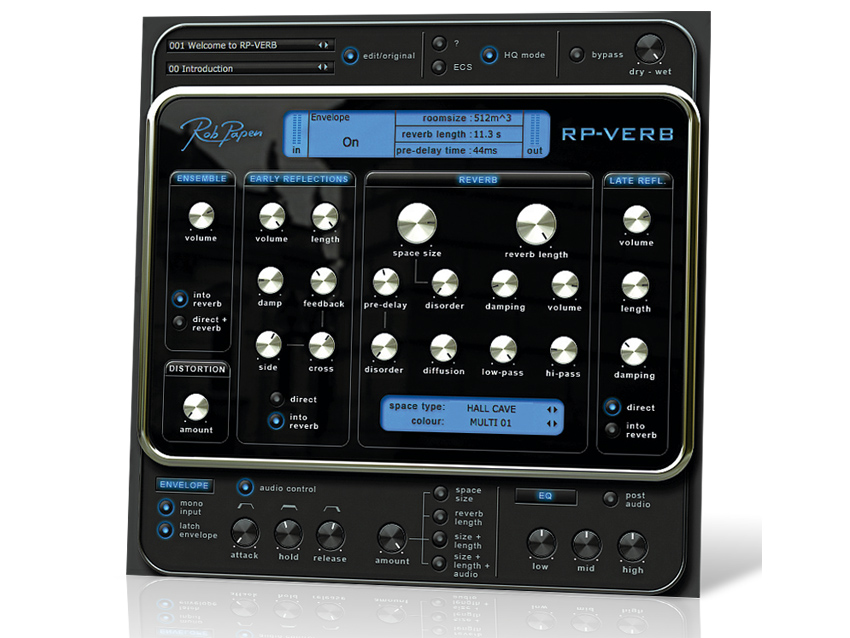MusicRadar Verdict
RP-Verb is a sound design powerhouse, though it's not for the faint-hearted.
Pros
- +
Awesomely powerful. Has a unique sound. Rewards real-time tweaks/automation. Clearly laid out. Huge selection of presets.
Cons
- -
Tricky to master. Not ideal for day-to-day use.
MusicRadar's got your back
Renowned sound designer and soft synth developer Rob Papen isn't scared to stray from the beaten path, as he demonstrated with RG, his 'rhythm guitar synth'. And neither is his company lacking in the sound processing department, with synths like Predator blessed with a huge range of built-in effects.
For this first strictly-effects effort, though, Papen and his coding cohort Jon Ayres have pulled out all the stops to deliver an ultra-modern reverb.
In detail
We won't run through RP-Verb's features 'in order', as the routing is quite versatile, but let's start by looking at the major sections of the interface.
The core is, obviously, the Reverb panel, with Early- and Late-Reflection sections placed either side. All the controls you would expect are on offer, but with additional surprises, such as Side-Wise and Cross controls for early reflections, which affect the amount of signal 'bleed' between the left and right sides, to simulate different room properties.
For the Reverb section's Pre-Delay and Space controls, you also get Disorder controls, which are designed to affect the build-up of early reflections and manipulate the shape of the virtual space.
It's suggested that these work best with Room reverb types, but they can be great for experimenting with. It's a little like having a room full of 'stuff' (as opposed to an empty one) and can give a more complex sound.
But the greatest creative potential comes from the inclusion of processing options that are quite unconventional for a reverb, such as input distortion and ensemble sections. Not only that, but the reverb's size, length and/or volume can be manipulated by an envelope that's triggered by the input signal, allowing for some serious sound-shaping. There's a three-band EQ, too.
"The greatest creative potential comes from the inclusion of processing options that are quite unconventional for a reverb, such as input distortion and ensemble sections."
Another plus point comes in the form of numerous routing options for the various signal paths and connections between the direct and affected signals. This alone is a hugely powerful way to alter the resulting sound. One drawback, though, is that when changing a parameter, it can be quite disorienting to keep looking back and forth between the knob and the main display - a pop-up over the former would help here.
It's also fair to say that RP-Verb often sounds decidedly 'digital', albeit in quite a pleasing manner. Clearly, this is something that's quite subjective and, indeed, it may be exactly what you're after.
Modulation options
We've can't stress enough RP-Verb's supreme potential for creating unique textures based on modulation. To add real-time modulation, you can draw in automation in your DAW or record your movements as you tweak the parameters. However, this isn't the most hands-on way to work and it's only possible to edit one parameter at a time using on-screen input.
This is where MIDI control comes in. Assigning controls to MIDI in RP-Verb is as easy as right-clicking a MIDI parameter, selecting Latch To MIDI and moving the desired controller. The same menu is also used to unlatch MIDI controls.
Once you have these sorted, you can save your RP-Verb MIDI setup preferences as presets, which can be particularly handy if you have different controllers in use at different times. It also gives you the option to swap and download presets designed for specific bits of hardware.
Summary
Hidden strength RP-Verb isn't your everyday utility reverb, then. Rather, its strength lies in its potential for creativity. There are more realistic and easier-to-use reverbs and, arguably, those that offer better value for money, but when it comes to making crazy noises and generating wild sweeps of enveloping sound, there's something about the way this plug-in's parameters and controls are set up that makes it an absolute joy to fiddle with, yielding all manner of crazily futuristic or delightfully distorted sounds.
If you're a serious sound designer who likes doing weird and wonderful things, you'll be able to get some unique textures and effects out of RP-Verb, and there aren't many parameters that don't respond well to real-time modulation. If you're not, you're probably better off opting for one of the many excellent simpler reverberation options on the market.
Listen to the RP-Verb in action:
Big distorted drums
The works
Reverb length automated
Disorderly
Natural room
Computer Music magazine is the world’s best selling publication dedicated solely to making great music with your Mac or PC computer. Each issue it brings its lucky readers the best in cutting-edge tutorials, need-to-know, expert software reviews and even all the tools you actually need to make great music today, courtesy of our legendary CM Plugin Suite.

“I don't know how to do this. You would think I do, but it's not one of these things you ever know how to do”: Why Paul McCartney’s intuition-led attitude to songwriting is worth taking onboard

“Ironic, self-aware, intimate, DIY... a song that builds power as it unfolds”: The making of Bad Guy, Billie Eilish’s biggest hit

NAMM 2025: “This innovative neck-to-body construction delivers more tone, sustain, and stability”: Eastman debuts the FullerTone series – all-new bolt-on electrics with a retro vibe and innovative neck joint
Most Popular









